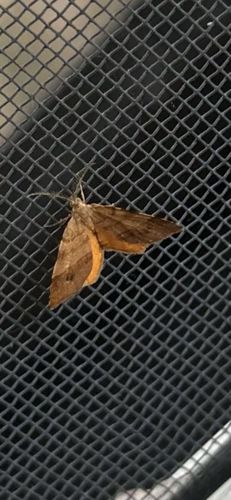It is difficult to determine the exact common name without more specific features, but it appears to be a type of Owlet Moth or a related Noctuidae moth. It shares characteristics with species like the Small Yellow Underwing (Noctua comes) due to the yellow/orange hindwings, though its forewings are primarily brown with subtler markings, or possibly a related species within the family.
Scientific Name: Pinpointing a precise scientific name from a single image with limited detail is challenging, but it likely belongs to the family Noctuidae, which is one of the largest families of moths. A potential candidate, resembling some features, could be within the genus Noctua (e.g., Noctua comes if the underwing is distinctly yellow/orange, though the forewing pattern might vary) or a related noctuid genus.
Order & Family: Order: Lepidoptera, Family: Noctuidae (Owlet Moths or Armyworm Moths)
Size: Most moths in the Noctuidae family range from small to medium-sized, with a wing span typically between 25 mm to 50 mm (1 to 2 inches). Based on the image and the mesh background, this moth appears to be in that generally medium size range for its family.

Natural Habitat
Moths like this are generally found in diverse habitats, including woodlands, gardens, meadows, agricultural areas, and urban environments where host plants for their larvae are abundant. They are widespread and adaptable.
Diet & Feeding
Adult moths often feed on nectar from flowers, tree sap, rotting fruit, or may not feed at all if their primary purpose is reproduction during their short adult life. The larvae (caterpillars) are typically herbivorous, feeding on the leaves of a wide variety of plants, depending on the specific species.
Behavior Patterns
This specific moth is likely nocturnal, attracted to lights at night, and remains still during the day to avoid predators. Moths typically undergo complete metamorphosis with egg, larval (caterpillar), pupal, and adult stages. The adults are mostly active at night and are generally drawn to artificial light sources. During the day, they rest, often camouflaged on tree trunks, leaves, or other surfaces.
Risks & Benefits
Risks: Some moth larvae (caterpillars) can be considered agricultural pests if they feed on crops in large numbers. A few species' caterpillars have urticating hairs that can cause skin irritation. Benefits: Adult moths are important pollinators for various plants, especially nocturnal flowers. Larvae serve as a food source for many animals, including birds, bats, and other insects, contributing to the food web.
Identified on: 8/11/2025